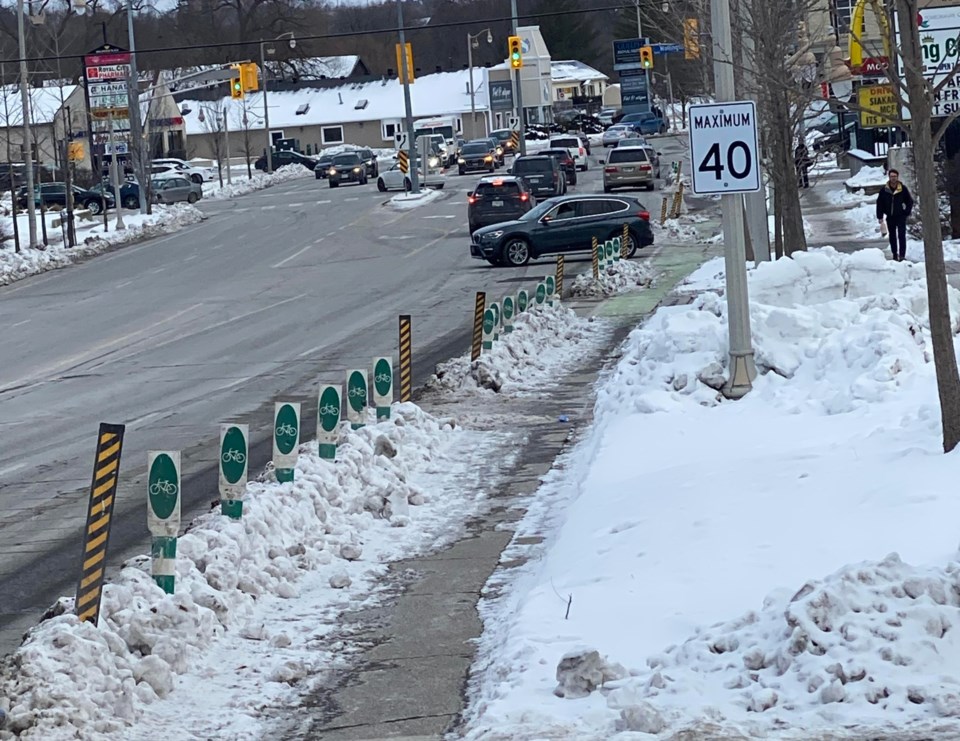Not enough is being done to keep bike lanes clear of snow and ice, say cycling advocates, pointing to potentially treacherous situations that linger long after significant snowfalls.
More than a week after city officials declared a “significant weather event” on Jan. 12 and conducted a plow-out of city streets that weekend, numerous bike lanes continued to be significantly covered.
This, cycling advocates agree, poses dangerous situations for bike riders and those in vehicles.
“I don’t want to have to sue the city as a result of me falling or being hit by a vehicle,” said cyclist Mike Darmon. “I just want to do my part for the climate and arrive at my destination injury-free and get back home alive.”
Snow, slush and ice in bike lanes make it “super slippery” for cyclists, agrees Andrea Bidgood, calling winter maintenance efforts in Guelph “inadequate.”
“It’s quite messy,” she said. “One little move from either myself or my bike, or even a driver, potentially means me under the wheels (of a motor vehicle).”
Darmon and Bidgood, who are both members of the Guelph Coalition for Active Transit (GCAT), have recorded some of their recent travels and posted the video on social media to raise awareness of the issue.
Those videos show partially snow-covered bike lanes along York Road and Gordon Street on Jan. 17 and 23 respectively.
Guelph and our protected bike lane (singular).
— Andrea Bidgood (@Andreabigfoot) January 23, 2024
I would have actually taken the lane like I have all week but I wanted footage. Yes I'm dramatic but "I'm going to die" did pop out of my mouth and then I decided to go back to the driving lane. @TheBikingLawyer pic.twitter.com/yIgJO6hC9E
At this time, GCAT hasn’t formally taken a stance on the issue, but Bidgood said that might change during a Thursday meeting of the group’s advocacy committee.
The city’s snow clearing efforts meet minimum provincial maintenance standards, public works compliance specialist Eleanor Gillon told GuephToday via email.
“The standards include any designated bike lane that is signed, or pavement marked as such and includes the lanes with a physical /marked buffer,” she said via email. “Snow clearing in bike lanes can be challenging; snow equipment is space restricted within the lanes with physical buffers and some lanes are impacted by both sidewalk and roadway plowing, all which compete for snow storage space.”
That minimum standard varies depending on the classification road bike lanes are on, Gillon explained, referring to arterial, collector and residential roads.
The minimum requirement is that snow be “cleared from the roadway to within a distance of 0.6 metres inside the outer edges of the roadway.”
I really want to bicycle all winter!
— Mike Darmon (@MikeDarmon1) January 17, 2024
I really want to help get our City Transportation MP mode share goals to less car use.
I want to help achieve our @cityofguelph Net0 commitment
This is not helping!@speedriverbike @_BackPeddling_ @emergeguelph @activeguelph @TheBikingLawyer pic.twitter.com/MzXWV4K57I
The city’s first significant weather event of the season was declared at 5 p.m. on Jan. 12 and was called off shortly after 9 a.m. on Jan. 15. During that time, Environment Canada reports Guelph received nearly 26 cm of snow.
In the declaration post on the city website, officials said it may take until 24 hours after the snow stopped falling to have “all roads cleared and up to three days for sidewalks.”
That didn’t happen, at least not completely, as many bike lanes remained filled or partially covered with snow for more than a week, including on sections of major roads like Gordon and Woolwich streets as well as York Road.
Bidgood encourages anyone who has concerns about bike lane maintenance to report it to the city, which can be done online here. Complaints can also be lodged by emailing [email protected] or calling 519-826-9771.


































